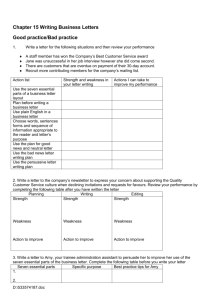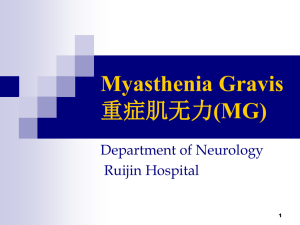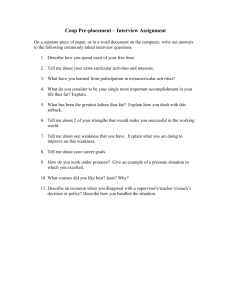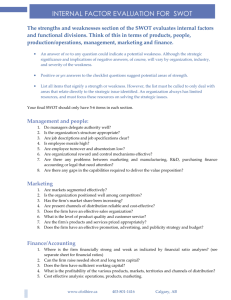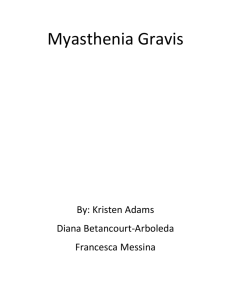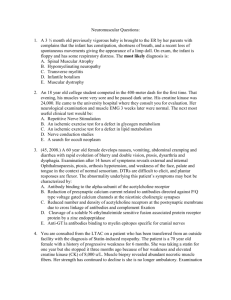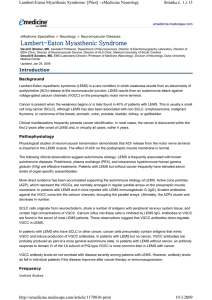Disorders of neuromuscular junction:
advertisement
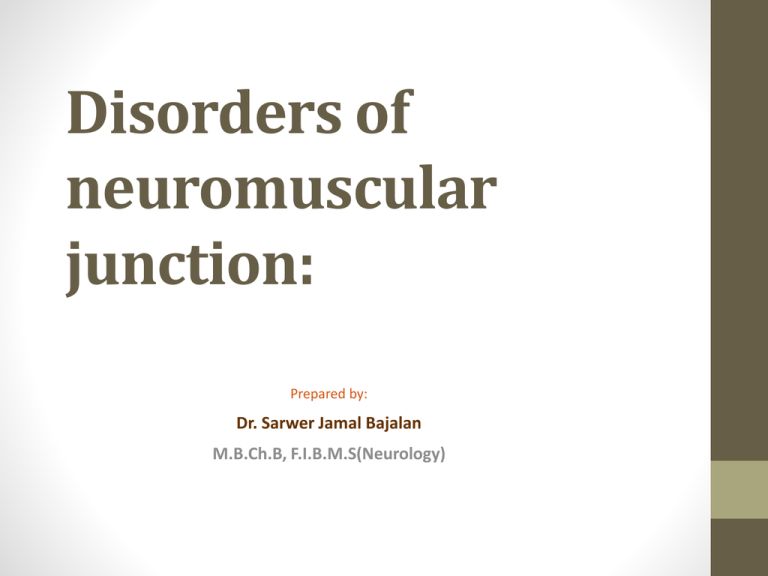
Disorders of neuromuscular junction: Prepared by: Dr. Sarwer Jamal Bajalan M.B.Ch.B, F.I.B.M.S(Neurology) Myasthenia Gravis Epidemiology • Occurs in 50–125/1,000,000. • Bimodal distribution, often affecting females in their second and third decades, and males in their sixth and seventh decades. Pathophysiology • Autoimmune disease with antibodies against acetylcholine receptor, results in decrease of the nicotinic AChR at NMJ. • End-plate potentials (EPPs) have decreased amplitude and do not trigger a muscle action potential. • With repeated contractions, more fibers fail to contract, leading to fatigue. • Thymus is abnormal in 75% of cases (15% thymoma, 85% thymic hyperplasia). • May be associated with other autoimmune diseases: thyroiditis, Graves disease, RA, SLE, pernicious anemia, Addison disease & vitiligo. Clinical manifestations • Fatigable weakness • Diplopia and ptosis are the most common presenting features. • In 15%–20%, the disease never progresses beyond ocular muscles (Ocular MG). • Bulbar weakness, limb weakness, and respiratory weakness may occur. • Weakness may get worse as the day goes on ( diurnal variation). • In patients with longstanding disease, weakness may be fixed. • No pain, sensory loss, or reflex abnormalities. Symptoms of MG exacerbated by • • • • • • Superimposed infection Surgery Hyperthyroidism (found in 3%) Drugs that affect neuromuscular transmission Anesthetics that cause neuromuscular blockade Antibiotics (aminoglycosides, quinolones, some macrolides, possibly penicillins) • Antihypertensives (beta blockers, verapamil) • Anti-arrhythmic drugs (quinine, procainamide) • Other: magnesium, phenothiazines, chloroquine, lithium, some antiepileptics, iodinated contrast agents • Penicillamine can cause a drug-induced myasthenic syndrome in people without autoantibodies Investigations Laboratory • Acetylcholine receptor antibodies (AChR Ab) present in 85% of patients with generalized MG and 50% of patients with ocular MG. • A subgroup of AChR Ab -negative patients will have antibodies to musclespecific kinase (MUSK Ab) instead. • Striated muscle antibody occurs in 90% of patients with MG and thymoma, compared to 30% in all MG patients. • Consider screening for associated autoimmune diseases with: • • • • Thyroid function studies, Thyroid antibodies, Vitamin B12, and Intrinsic and gastric parietal cell antibodies. Electrodiagnostic testing • Repetitive stimulation of CMAP shows decrement at rest. After brief exercise, the decrement repairs, and then gradually worsens over 3 minutes. Sensitivity 50%–60%, better with proximal muscles. • Single-fi ber EMG shows increased jitter and blocking (90% sensitive, but specificity is not as high). CT of the thorax with contrast is essential to look for thymic enlargement suspicious for thymoma. Pharmacologic Test Edrophonium (Tensilon) test Edrophonium is a short-acting cholinesterase inhibitor. • An easily testable muscle must be selected , often the deltoid, finger extensors, or levator palpebrae. The latter is especially useful in a neuro-ophthalmology offi ce, where degree of ptosis can be quantified. • Prepare two syringes. One has 1 mL of saline, and one has 10 mg of edrophonium in a 1 mL solution. • Inject the saline first and observe for 1 minute, looking for improvement in strength. • Inject 2 mg of the edrophonium. If no improvement after 1 minute, inject the remaining 8 mg. If no improvement after 1 minute, the test is negative. • Atropine (0.4 mg, repeat every 3–10 minutes as needed) can be used to counteract side effects, including asystole, bradycardia, nausea, excessive salivation and lacrimation, increasing weakness and fasciculations. Differential diagnosis Generalized MG • Lambert–Eaton syndrome • Botulism • Drug-induced myasthenia (penicillamine) • Congenital myasthenic syndromes (defects in neuromuscular transmission that are not caused by autoimmune disease) • Inflammatory myopathies • Motor neuron disease (especially bulbar onset) Ocular MG • Thyroid ophthalmopathy • Mitochondrial disease (progressive external ophthalmoplegia) • Intracranial lesion (cavernous sinus) • Wernicke encephalopathy • Oculopharyngeal muscular dystrophy Management Pyridostigmine • Good first-line agent • A cholinesterase inhibitor • Acts within 1 hour with duration about 4 hours • Starting dose 30–60 mg bid-tid. Titrate to effect (often up to 60 mg five times a day). Higher doses can be used but side effects may be limiting. • Side effects: GI upset, diarrhea, excessive salivation, Fasciculations Overdose can cause cholinergic crisis, with increased bulbar and respiratory weakness. • Side effects can be treated with decreasing the dose, or adding glycopyrrolate 1 mg qd to bid. Prednisone • Good second-line agent if pyridostigmine is inadequate. • Note that about half of patients will initially worsen 7–21 days after steroids are started. • Start with 10 mg on a ternate days, increased every 2 or 3 days to 1–1.5 mg/kg on alternate days. • Improvement begins after 2–4 weeks with maximal benefit at 6 to 12 months. • After 3 months or when remission is evident, the dose is slowly tapered to the minimum dose required. Often a small dose is required to prevent relapse. • All patients should be treated for osteoporosis with calcium, vitamin D, and a bisphosphonate. Flowchart for the management of MG Other Immunosuppressants • Used when steroids are insufficient or contraindicated, or when steroid side effects are dose limiting. • Response may take 3–12 months. • Follow CBC and LFT every week for 2 months and then every 3 months after that. Azathioprine • Thiopurine methyltransferase (TPMT) level may predict risk of hematologic side effects. • Dose: 50 mg/day for 1 week increasing by 50 mg/week to a goal dose of 2.5 mg/kg/day • Side effects: Hypersensitivity reaction, bone marrow suppression, hepatotoxicity Cyclosporine • Dosages of 2–5 mg/kg/day in two divided doses • Side effects: nephrotoxicity, hypertension • Monitor trough drug levels Cyclophosphamide • Reserved for severe cases • Oral or intravenous Etanercept, Rituximab, Tacrolimus, Mycophenolate mofetil at 1000 mg bid is commonly used Plasma exchange Indications: • Myasthenic crisis with bulbar weakness and respiratory compromise • Perioperative morbidity from thymectomy • Rarely, as maintenance therapy when other modalities have failed. • Five to six exchanges over 2 weeks, 2–4 L per exchange. • Improvement usually noted within days, lasting 1–12 weeks. Side effects • Bleeding from removal of circulating clotting factors • Hypotension and bradycardia • Transient electrolyte disturbances • Side effects related to need for vascular access (line infections, local thrombosis, vascular perforation) IV immunoglobulin • Indications and time course for benefit similar to plasma exchange • Dose: 400 mg/kg/day for 5 days (total: 2 g/kg) • If used for maintenance, 1 g/kg q2–4 weeks. • Side effects • Common: headaches, nausea, flu-like symptoms • Serious: Renal failure, anaphylaxis, risk of hypercoagulability Thymectomy Indications • Thymoma Therapeutic benefit — No good trials, but consensus is that it is helpful in patients under 45 with AChR antibodies — More effective in generalized MG than ocular MG — Benefits may not be evident for months or years after surgery. — Can be curative in a fraction of patients • Mortality is low in the hands of experienced surgeons • Consider pre-operative plasma exchange to reduce the risk of MG exacerbation immediately following surgery. Women and MG MG and pregnancy Therapy • Pyridostigmine and plasma exchange are probably safest. • There is a low risk of fetal malformations with prednisone. • Azathioprine and mycophenolate are teratogenic. • In patients with eclampsia, magnesium sulfate should be avoided if possible. • Exacerbations during and after pregnancy are common. Neonatal MG • 14% of babies born to mothers with MG develop neonatal MG due to placental transfer of maternal antibodies. • Weakness may be apparent days after birth and last for days or months. • Treat supportively. Lambert-Eaton Myasthenic Syndrome (LEMS) Pathophysiology • 60% are paraneoplastic, usually associated with small cell lung cancer. Usually, the discovery of LEMS predates the discovery of cancer. • 40% are autoimmune (usually in younger, female patients). • Both have voltage-gated calcium channel antibody. Clinical manifestations • Proximal > distal weakness, often worse in the lower extremities • Weakness may improve with sustained exercise. • Reflexes are diffusely low or absent, but may appear after exercise. • Cranial nerve involvement in about 30% (diplopia, ptosis, dysarthria, dysphagia) • Autonomic dysfunction (dry mouth, blurred vision, constipation, erectile dysfunction) Investigations of LEMS NCS & EMG • Reduced CMAP amplitudes that facilitate >200% with rapid repetitive stimulation (>30 Hz) or after brief intense exercise. •Decrement on slow (2 Hz) repetitive stimulation. • Single-fiber EMG may show increased jitter. Laboratory P/Q voltage-gated calcium channel Abs SOX1 Ab (50% sensitivity in patients with paraneoplastic LEMS) Chest CT or MRI To look for occult tumor. If negative, Repeat at regular intervals for 5 years or until tumor is discovered. Management of LEMS • Treat underlying tumor, if present. • Pyridostigmine Same doses as for MG Usually only partially effective • Diaminopyridine • Guanidine • Plasma exchange • IV Immunoglobulin Botulism Pathophysiology • Botulism is poisoning by a toxin produced by clostridium botulinum. • Most commonly comes from inadequately sterilized canned or prepared foods. • Adult botulism is caused by ingestion of toxin; infantile botulism is caused by ingestion of live bacteria (i.e., in honey). Clinical manifestations • Occur 6–48 hours after ingestion • Diffilculty with convergence, ptosis, paralysis of extraocular muscles • Dilated, poorly reactive pupils, other autonomic dysfunction • Jaw weakness, dysarthria, dysphagia • Spreads to trunk and imbs • Rare cardiac or respiratory involvement Investigations • NCS show incremental response with rapid repetitive stimulation, mimicking LEMS • Laboratory: Serum analysis for toxin by bioassay in mice. Management • Monitor respiration closely, mechanical ventilation if indicated • Equine serum trivalent botulism antitoxin. • Do not wait for positive toxin assay if clinical suspicion is high. • Side effects: anaphylaxis (3%), serum sickness (20%)

